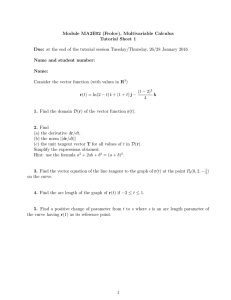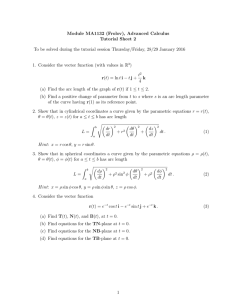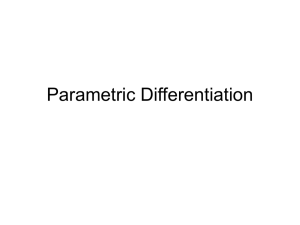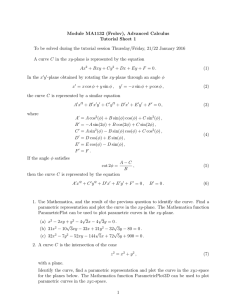Vector-Valued Functions 1 Parametric curves
advertisement
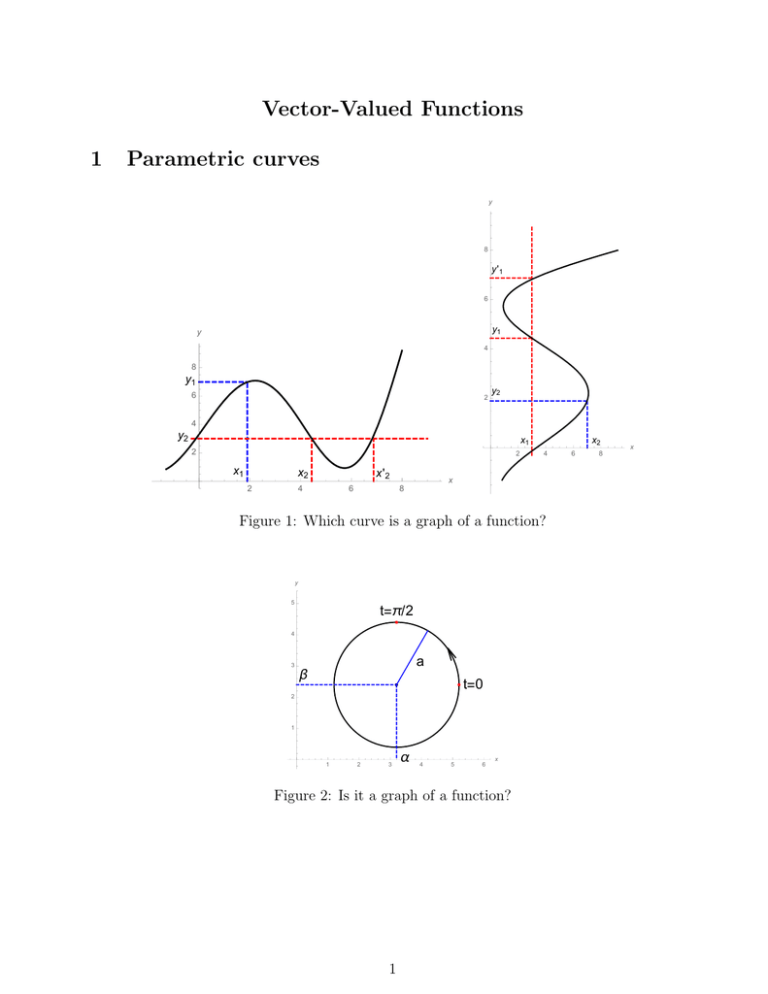
Vector-Valued Functions 1 Parametric curves y 8 y'1 6 y1 y 4 8 y1 6 2 y2 4 y2 x1 2 2 x1 x2 2 x'2 4 6 x2 4 x 8 Figure 1: Which curve is a graph of a function? y 5 t=π/2 4 3 a β t=0 2 1 1 2 3 α 4 5 6 x Figure 2: Is it a graph of a function? 1 6 8 x y 5 t=π/2 4 3 a β t=0 2 1 1 2 3 α 4 5 6 x Figure 3: This curve is not a graph of a function. This curve is a circle of radius a centred at (α, β) (x − α)2 + (y − β)2 = a2 It is a parametric curve which can be represented by the eqs x = α + a cos t , y = β + a sin t , 0 ≤ t ≤ 2π . In general in 2-space a parametric curve is x = f (t) , y = g(t) , t0 ≤ t ≤ t1 . The graph of a function y = f (x) is a parametric curve x = t, y = f (t) . The graph of a function x = f (y) is a a parametric curve x = f (t) , 2 y = t. z t=10 t=0 t=100 x y t=1 orientation Figure 4: A parametric curve in 3-space x = f (t) , y = g(t) , z = h(t) , t0 ≤ t ≤ t1 . These parametric eqs generate a curve in 3-space called the parametric curve represented by the eqs, and as t increases the point moves in a specific direction which defines the curve orientation. A parametric curve can be considered as a path of a point particle with the parameter t identified with time. A parametric curve in n-space is represented by n eqs x1 = f1 (t) , x2 = f2 (t) , ··· , 3 xn = fn (t) , t0 ≤ t ≤ t1 . Example 1. (x − α)2 (y − β)2 + = 1. a2 b2 y 4 3 y 2.5 2.0 2 1.5 1.0 1 0.5 1 2 3 4 x 0.5 1.0 Figure 5: These are ellipses. This ellipse can be represented by the eqs x = α + a cos t , y = β + b sin t , 4 0 ≤ t ≤ 2π . 1.5 2.0 2.5 x Example 1. Ellipse (x − α)2 (y − β)2 + = 1. a2 b2 Example 2. (x − α)2 (y − β)2 − = 1. a2 b2 (x − α)2 (y − β)2 − = −1 . a2 b2 y y 3 3 2 2 1 1 2 -2 4 6 x 2 -2 4 6 x Figure 6: These are hyperbolas. The right (black) branch of the first hyperbola can be represented by the eqs x = α + a cosh t , y = β + b sinh t , −∞ < t < ∞ . because cosh t = et + e−t > 0, 2 sinh t = et − e−t , 2 cosh2 t − sinh2 t = 1 . HW: Find a representation of the left (blue) branch of the first hyperbola, and similar representations of both branches of the second hyperbola. 5 Example 1. Ellipse (x − α)2 (y − β)2 + = 1. a2 b2 Example 2. Hyperbolas (x − α)2 (y − β)2 − = 1. a2 b2 (x − α)2 (y − β)2 − = −1 . a2 b2 Example 3. y = ax2 . y 2 = ax . y y 2 8 1 6 0.5 4 -1 1.5 x -1 2 -2 1.0 1 2 x -2 Figure 7: These are parabolas. They can be represented by the eqs x = t, y = at2 , 1 x = t2 , a y = t, Ellipses, hyperbolas and parabolas are conic sections. 6 −∞ < t < ∞ . Example 4. x = a cos t , y = a sin t , z = vt , −∞ < t < ∞ . x = a sin t , y = a cos t , z = vt , −∞ < t < ∞ . Figure 8: These are circular helixes. Example 5. Line through ~r0 = (x0 , y0 , z0 ) in the direction of the vector ~v = (vx , vy , vz ) x = x0 + vx t , y = y0 + vy t , z = z0 + vz t , −∞ < t < ∞ . Example 5b. Find parametric equations for the line through (2, 0, 0) and (0, 4, 3). ��������� Figure 9: This is the line through (2, 0, 0) and (0, 4, 3). Let t = 0 correspond to (2, 0, 0), and let t = 1 corresponds to (0, 4, 3). Then, x(1) = x0 + vx = 0 =⇒ vx = −2 , y(0) = y0 = 0 , y(1) = y0 + vy = 4 =⇒ vy = 4 , z(0) = z0 = 0 , z(1) = z0 + vz = 3 =⇒ vz = 3 . x(0) = x0 = 2 , Thus x = 2 − 2t , y = 4t , z = 3t , 7 −∞ < t < ∞ . Example 5. Line through ~r0 = (x0 , y0 , z0 ) in the direction of the vector ~v = (vx , vy , vz ) x = x0 + vx t , y = y0 + vy t , z = z0 + vz t , −∞ < t < ∞ . Example 6. The same line as in Example 5 1 x = x0 − vx t , 2 1 y = y0 − vy t , 2 1 z = z0 − vz t , 2 −∞ < t < ∞ . Example 7. The same line as in Examples 5 and 6 1 x = x0 − vx (t − t0 ) , 2 1 y = y0 − vy (t − t0 ) , 2 1 z = z0 − vz (t − t0 ) . 2 Example 8. This is a segment of the same line as in Examples 5, 6 and 7 x = x0 + vx t3 , y = y0 + vy t3 , z = z0 + vz t3 , −1 ≤ t ≤ 1 . Example 9. This is a segment of the same line as in Examples 5, 6 and 7 but it is run twice! x = x0 + vx (t − 1)2 , y = y0 + vy (t − 1)2 , z = z0 + vz (t − 1)2 , 0 ≤ t ≤ 2. ∃ ∞ many parametric eqs representing the same curve. Make a change t = γ(τ ) where γ(τ ) is a one-to-one function on the interval τ0 ≤ τ ≤ τ1 of interest. t t t18 1.0 6 0.5 4 -1.0 t0 0.5 -0.5 1.0 τ -0.5 2 -1.0 -0.5 τ0 0.5 1.0 1.5 2.0 τ12.5 τ t = τ 3; Figure 10: γ(τ0 ) = t0 , γ(τ1 ) = t1 ; The parameterisations are considered as equivalent if γ 0 (τ ) 6= 0 for τ0 ≤ τ ≤ τ1 . If γ 0 (τ ) > 0 the curves have the same orientation. Example. x = cos t , t = −τ t=τ− =⇒ π 2 =⇒ y = sin t , x = cos τ , x = sin τ , 8 y = − sin τ , y = − cos τ . 2 Vector-Valued Functions x = f (t), y = g(t), z = h(t) ~r(t) = x(t), y(t), z(t) z ~r(t) = f (t)~i + g(t)~j + h(t)~k r(t) Thus, ~r is a function of t: ~r = ~r(t). k i y j x This is a vector-valued function of a real variable t. x(t), y(t), z(t) are components of ~r(t). The graph of ~r(t) is the parametric curve C described by the components of ~r(t). ~r(t) is called the radius vector for the curve C. The domain of ~r(t) is the intersection of domains of x(t), y(t), z(t). It is called the natural domain of ~r(t). Example. ~r(t) = √ t − 1~i + ln(3 − t)~j + 1 ~ k. t−2 D(~r) = [1, 2) ∪ (2, 3) . 3 Vector form of a line segment r0 If ~r0 is a vector with its initial point at O t(r1 - r0) then the line through the terminal point ~r0 and parallel to ~v is r ~r = ~r(t) = ~r0 + t ~v . r1 So, ~r(0) = ~r0 , ~r(1) = ~r1 = ~r0 + ~v O ⇒ ~r(t) = ~r0 + t(~r1 − ~r0 ) = (1 − t)~r0 + t ~r1 This is a two-point form of a line. If 0 ≤ t ≤ 1, then ~r = (1 − t)~r0 + t ~r1 represents the line segment from ~r0 to ~r1 . 9 4 Calculus of Vector-valued Functions lim ~r(t) = t→a lim x(t) ~i + lim y(t) ~j + lim z(t) ~k , t→a t→a t→a where all the three limits must exist. A vector-valued function is continuous at t = a (or on an interval I) if all its components are. Then lim ~r(t) = ~r(a) ∀a ∈ I . t→a Derivative of ~r with respect to t is the following vector ~r 0 (t) = x0 (t)~i + y 0 (t)~j + z 0 (t)~k . ~r(t) is differentiable if all its components are. Notations d ~r(t) , dt d~r , dt ~r 0 (t) , Derivative Rules 1. dtd a ~r1 (t) + b ~r2 (t) = a ~r1 0 (t) + b ~r2 0 (t) , 2. dtd f (t) ~r(t) = f 0 (t) ~r(t) + f (t) ~r 0 (t) , ~r 0 , ~r˙ (t) , ~r˙ , d [~r(t)] . dt a, b are const y y r(t+ϵ)-r(t) 8 r(t+ϵ) 8 6 r'(t) 6 r(t) r(t) →0 −−→ 4 4 C C 2 2 0.2 0.4 0.6 0.8 1.0 x 0.2 0.4 0.6 0.8 1.0 x If ~r 0 (t) 6= 0 and it is positioned with its initial point at the terminal point of ~r then ~r 0 is tangent to C and points in the direction of increasing parameter. In mechanics it is velocity of a particle moving along C. Example. √ π 3 ~r(t) = 2 cos t~i + 1 + 3e2t ~j + 2 ~r 0 (t) =? 10 Z 1 ln t e3u ~ du k . u 5 Tangent lines to graphs of vector-valued functions Let P be a point on the graph y 8 C of a VV function ~r(t), and let r ' (t0 ) ~r 0 (t0 ) 6= 0 where ~r(t0 ) is the P 6 radius vector from O to P . r(t0 ) Then, ~r 0 (t0 ) is a 4 C tangent vector to C at P , 2 and the line through P that is 0.2 0.4 0.6 0.8 1.0 parallel to ~r 0 (t0 ) is the tangent x line to C at P . The tangent line is given by the vector eq ~ R(t) = ~r0 + t ~v0 , The unit tangent vector is T~ = ~v |~v | = ~v0 = ~r 0 (t0 ) , ~r0 = ~r(t0 ) . ~ r0 . |~ r 0| Example. ~r(t) = a sin t~i + a cos t ~j + v t ~k , ~r 0 (t) =? , 6 |~r 0 (t)| =? , T~ (t) =? , π ~ R(t) at t = ? , 3 Derivatives of dot and cross products y 8 r2 ~r1 = (x1 , y1 , z1 ), ~r2 = (x2 , y2 , z2 ) . 6 ~r1 · ~r2 = x1 x2 + y1 y2 + z1 z2 r1 = |~r1 | |~r2 | cos α = ~r2 · ~r1 4 α 2 0.2 0.4 0.6 0.8 1.0 x 11 ~r1 × ~r2 = +(y1 z2 − y2 z1 )~i r1 x r2 −(x1 z2 − x2 z1 ) ~j +(x1 y2 − x2 y1 ) ~k r2 = α ~i ~j ~k x1 y1 z1 = −~r2 × ~r1 x2 y2 z2 |~r1 × ~r2 | = |~r1 | |~r2 | sin α , r1 ~r1 × ~r2 ⊥ ~r1 and ~r2 . d d~r1 d~r2 (~r1 · ~r2 ) = · ~r2 + ~r1 · , dt dt dt d~r1 d~r2 d (~r1 × ~r2 ) = × ~r2 + ~r1 × . dt dt dt Theorem. If |~r(t)| is a constant then ~r(t) · ~r 0 (t) = 0. Proof: d d (~r · ~r) = |~r|2 = 0 , dt dt d d~r d~r d~r (~r · ~r) = · ~r + ~r · = 2~r · , dt dt dt dt Thus, ~r(t) ⊥ ~r 0 (t), and T~ (t) ⊥ T~ 0 (t). Example. A curve on the surface of a sphere that is centred at the origin has |~r(t)|=const, thus ~r(t) ⊥ ~r 0 (t). 12 7 Integrals of Vector-valued Functions Z b ~r(t)dt = b Z a Z b Z b x(t)dt ~i + y(t)dt ~j + z(t)dt ~k a a a Example 1. Z 1 ( √ 3t + 1~i + e2t~j + 3 sin(πt)~k )dt = ? 0 Rules of integration Z b Z b Z b (c1~r1 (t) + c2~r2 (t))dt = c1 ~r1 (t)dt + c2 ~r2 (t)dt a a a ~ An antiderivative for a v-v function ~r(t) is a v-v function R(t) such that Z 0 ~ ~ +C ~ R (t) = ~r(t) =⇒ ~r(t)dt = R(t) Example 2. Z ( 1 ~ i + t cos(t2 − 1)~j )dt = ? t+1 Integration properties Z d ~r(t)dt = ~r(t) and dt Z ~ ~r 0 (t)dt = ~r(t) + C Fundamental Theorem of Calculus Z b ~ b = R(b) ~ ~ ~r(t)dt = R(t) − R(a) a a Example 3. Z 1 ( 0 1 ~ i + t cos(t2 − 1)~j )t = ? t+1 Example 4. Find ~r(t) given that 1 ~r 0 (t) = ( t+1 , t cos(t2 − 1) ), ~r(1) = (1, 3) 13 8 Arc Length Parametrisation We say that ~r(t) is smoothly parameterised or that ~r(t) is a smooth function of t if ~r 0 (t) is continuous and ~r 0 (t) 6= 0 for any allowed value of t. Geometrically it implies that the tangent vector ~r 0 (t) varies continuously along the curve. For this reason a smoothly parameterised function is said to have a continuously turning tangent vector. Example 1. ~r(t) = a cos t~i + a sin t ~j + vt ~k , ~r 0 (t) = ? Example 2. ~r(t) = t2 ~i + t3 ~j , ~r 0 (t) = ? Change of Parameter y y y 3.0 3.0 3.0 2.5 2.5 2.5 r(t) 2.0 s 2.0 r(s) 1.5 1.5 1.5 1.0 1.0 1.0 0.5 0.5 0.5 0.5 1.0 1.5 2.0 2.5 3.0 x 0.5 1.0 1.5 2.0 2.5 r(ϕ) 2.0 3.0 x 0.5 1.0 1.5 2.0 ϕ 2.5 3.0 x Figure 11: Parameters: time; distance travelled; angle φ A change of parameter in a v-v function ~r(t) is a substitution t = g(τ ) that produces a new v-v function ~r(g(τ )) having the same graph as ~r(t). Example. Find a change of parameter t = g(τ ) for the circle ~r(t) = cos t~i + sin t ~j, 0 ≤ t ≤ 2π such that the circle is traced (a) counterclockwise; (b) clockwise; as τ increases over the interval [0, 1]. Chain rule: d~r d~r dt = , dτ dt dτ t = g(τ ) . A change of parameter t = g(τ ) in which ~r(g(τ )) is smooth if ~r(t) is smooth is called a smooth change of parameter. It requires dt/dτ 6= 0 ∀τ and dt/dτ continuous. If dt/dτ > 0 it is positive change of parameter, if dt/dτ < 0 it is negative. 14 Arc Length as a Parameter z The arc length L of a parametric curve t=a x = x(t), y = y(t), z = z(t), a ≤ t ≤ b: L= t=b Rb r 2 a dx dt + 2 dy dt + 2 dz dt dt y x In a vector form ~r(t) = x(t)~i + y(t)~j + z(t)~k d~r dx dy dz = ~i + ~j + ~k dt dt dt dt =⇒ =⇒ Z b d~r L= dt a r d~r dx 2 dy 2 dz 2 = + + dt dt dt dt Z b |~r 0 (t)| dt . dt = a Example. x = a cos t y = a sin t z = vt 0≤t≤π L =? The length of arc measured along the curve from some fixed reference point can serve as a parameter. s=-2 1. Select an arbitrary point on the curve C to serve as a s=-1 - dir reference point O. s=0 O s=1 s=2 + dir 2. Choose one direction along C to be positive, and the other to be negative. 3. If P is a point on C, let s be the “signed” arc length along C from O to P , where s is positive/negative if P is in +/- parts of C. 4. x = x(s), y = y(s), z = z(s) is called an arc length parametrisation of the curve. It depends on the reference point and direction. Example. x = a cos t , y = a sin t , 15 0 ≤ t ≤ 2π Finding arc length parameterisation y r(t0 ) 8 O s 6 Z t d~r du s= t0 du r(t) P Since 4 C ds dt r > 0 it is a positive = d~ dt change of parameter from t to s. 2 0.2 0.4 0.6 0.8 1.0 x Example 1. ~r = cos t~i + sin t ~j + t ~k Example 2. A line through ~r0 and parallel to ~v Properties of arc length parameterisation d~r = > 0 (it is speed). 1. ∀t, ds dt dt r ds = =1 2. ∀s, the tangent vector has length 1: d~ ds ds d~r 3. If dt = 1 ∀t, then ∀t0 , s = t − t0 is the arc length parameter that as the reference point at t = t0 . 16

